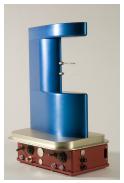

PI: Mark A. Zondlo, Princeton University, mzondlo@princeton.edu; Ph: 6092585037
Co-Is: Mark E. Paige, Steve M. Massick, and Joel A. Silver (Southwest Sciences, Inc.)

Description: The VCSEL hygrometer is an open-path, laser-based hygrometer that measures absolute concentration of water vapor (molecules per cm-3) at a rate of 1500 Hz which is co-averaged to a reporting frequency of 25 Hz. The instrument is designed for operation throughout the troposphere and lower stratosphere. Two water vapor absorption lines are used: a “weak” line at 1853.37 nm for lower tropospheric mixing ratios and a “strong” line at 1854.03 nm for middle and upper tropospheric concentrations. VCSELs have a wide current tuning capability and can probe each line by changing the laser injection current with only slight adjustments to the laser temperature. Switching between the absorption lines generally occurs near a fractional absorption of 10-3, though a hysteresis is built in to prevent rapid switching near this transition (generally a factor of two in each direction). The threshholds for line switching changes slightly with temperature and pressure, but it generally is in the -25 to -35 C frost point range.
Optomechanically, infrared light is end-coupled to a single mode fiber inside the red electronics box which sits inside the cabin below an aperture plate. The 29 cm high blue pylon resides above the fuselage skin. The pylon contains two, 1.9 cm diameter gold-coated, copper mirrors separated by 14.95 cm where light is passed 25 times between them for a total pathlength of 3.74 m. The VCSEL resides inside the electronics box and stays near cabin temperatures. VCSEL light is coupled into a single mode fiber within 20 microns of the laser facet and thereby prevents residual water vapor inside the cabin from creating an artifact in the measurement. A hermetic, fiberized feedthrough brings the laser light to the upper mirror (for START08; lower mirror on subsuquent missions) where a gradient index lens collimates the light. An extended wavelenght InGaAs detector resides in the lower mirror which has a focusing lens that collects light from a 7 degree angle and focuses it onto the detector. A filter removes extraneous light outside a 50 nm window centered at 1850 nm.
Second harmonic detection is used for most of the measurement range except for the upper (moist) range of the strong peak line where saturation effects may become important. Switching between direct and 2f mode for the strong peak takes at most three seconds. Switching between the strong line and weak mode takes 5 seconds when working optimally.
Local pressure and temperature are measured on the sensor, though aircraft static temperatures are used as a primary due to adiabatic compression on the VCSEL temperature probe. Flow modeling studies suggest the temperature of the VCSEL sampling region is about 1 K higher than ambient. The VCSEL pressure is the primary pressure sensor and generally agrees well with the aircraft static pressure data except at the highest aircraft speeds where it reads up to 6% higher. Flow modeling calculations suggest this is a real effect, and therefore no attempt is made to correct the pressure based on the aircraft data.
Performance in START08/PreHIPPO:
The instrument was initially used in a test mode for START08/PreHIPPO, and no data was
obtained for the first three flights due to linelocking problems. Subsequent flights showed
improvement, though transitions between lines at times took much longer than expected (minutes
to tens of minutes) due to software problems with the linelocking. Also, the first deployment of
START08 used temperatures from the VCSEL probe which were impacted by adiabatic heating
of the VCSEL probe which also enhanced the linelocking problems (incorrect temperatures
influenced the peak transitions). The second deployment used the variable ATX for the
temperatures, and significant improvement occurred.
A large etalon, or optical interference fringe, existed in the fiber optic feedthrough for the entire campaign. This etalon significantly degraded precision at the lower ranges of each absorption line, and it also created some problems in the line switching when the signal locked onto an etalon instead of the ambient signal. All transitions were removed for at least three seconds on either side for START08, and no final data were archived when errors were reported.
Accuracies were based upon standard dilution of flows (wet/dry flow mixed together) for > 100 ppmv, constant temperature organic phase change baths at 1-6000 ppmv (acetone/liq. N2; chloroform/liq. N2; acetonitrile/liq. N2; benzyl alcohol/liq. N2; ice/water), and chilled mirror hygrometers above 0 C. Each line was calibrated independently of the others. Based upon these results, the blind AquaVIT water vapor intercomparison study, and calibrations done before, during, and after the experiment, we estimate uncertainty in the total measurement to be 10%. No change in calibrations occurred during STRAT08 for the raw aircraft data, and all final data was post-processed with correct temperatures and appropriate calibrations applied. Precision was better than 1% for most conditions, though the lower range of the weak line approached 5% at times. The lowest mixing ratios in the UT/LS at times had 3% precision for some, but not all, of the < 5 ppmv data. The nature of the precision was at variable within these ranges.
Summary for START08/PreHIPPO:
Accuracy: 10%
Precision: <=3%
Frequency: 25 Hz
Data coverage: RF04-18 (RF06 had snow/ice/dirt on mirror prior to takeoff; limited coverage)
Location: top, forward, right aperture plate (RBL 13, GVFS 255)
Final data was archived as both number density and mixing ratio using the VCSEL local pressure and ATX tempeatures. Dewpoints were calculated using Murphy and Koop formulation.
Please contact the PI for more detailed information and manuscripts in preparation on the VCSEL hygrometer (updated 7/8/2009).